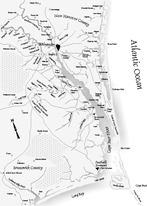Cape Fear River Settlements
Attempts to explore and colonize North Carolina's Cape Fear region (now Brunswick, New Hanover, and other southeastern counties) spanned 200 years prior to the permanent occupation of the area by English settlers. Although first discovered by Giovanni da Verrazano on behalf of France in 1524, a Spanish expedition under Lucas Vasquez de Ayllon entered the river in 1526 and explored its banks before moving farther south to establish an ill-fated settlement. In 1662 William Hilton explored the river on behalf of Massachusetts Bay colonists. As a result of Hilton's report, New England Puritans went to the area in 1663, only to leave almost immediately after posting a notice at the point of Cape Fear disparaging the land along the river.
By the early summer of 1664, a group of "adventurers" from Barbados, led by John Vassall, settled in Lower Cape Fear, encouraged by a second voyage to the river by Hilton. Vassall and his party proceeded to the newly created Clarendon County without awaiting the outcome of negotiations with the Lord Proprietors for the terms of settlement. Vassall's colony founded Charles Towne about 20 miles upstream near the mouth of what later became Town Creek. The settlement rapidly grew to almost 800 persons, but untenable terms for settlement by the Lords Proprietors led to its decline. After negotiations with the Proprietors failed, the Proprietors appointed Vassall's rival, Sir John Yeamans, as governor of Clarendon County. Yeamans, who preferred a settlement farther south, discouraged colonization on Cape Fear. Because of the unfavorable decisions from the Lords Proprietors, along with growing hostility among the local Indian population, settlers fled the region. By early 1667 Clarendon County was inhabited only by its Native American population.
The earliest permanent settlement of the Cape Fear Valley took place in the spring of 1726, when Maurice Moore occupied lands on the south side of the river and laid off the town of Brunswick about 12 miles above its mouth. After the failure of the Vassall colony, the region had remained uninhabited except by native tribes until 1724-25, when Governor George Burrington spent the winter exploring the Cape Fear River and contemplating its potential development. In 1725 he issued grants for almost 9,000 acres in the area, primarily to a powerful group of settlers who were joined by blood and marriage. "The Family," as they came to be known, included Maurice, Roger, James, and Nathaniel Moore of South Carolina, along with the prominent North Carolina Allen, Porter, Moseley, and Swann families, all of whom were joined by marriage.
Although these important families acquired more than 100,000 acres along the river and dominated the initial landholdings in the region, rival settlers poured into Cape Fear during the 1730s, establishing the town of Wilmington and pressing upriver on both the northwest and northeast branches of the river. Wilmington, located on the east bank of the river near the fork in its branches, quickly replaced Brunswick Town as the center of commerce for Lower Cape Fear and as the seat for New Hanover County. By the outbreak of the American Revolution, the younger town was vying to become the leading municipality in the province, whereas Brunswick would soon be taken over by the forest that bordered the river.
The arrival of Gabriel Johnston in 1734 as governor of the colony of North Carolina ushered in a period of rapid growth in the Cape Fear region. Thousands of Scottish Highlanders settled as far as 100 miles above Wilmington. By 1760 a community known as Cross Creek was established at the head of navigation for the river, and two years later the town of Campbellton was founded nearby. The communities were combined as Fayetteville in 1783.
In addition to the English and Scottish Highlander colonists, a variety of other nationalities attempted to settle in the region. A group of Welsh homesteaders sought to occupy the area between Cape Fear (Northwest Branch) and the Northeast River. Although little is known about the venture or its degree of success, their location continued to be known as the Welsh Tract as late as the Revolutionary War period. Developers also looked for substantial tracts of land on which to establish settlements of Irish Protestants and Swiss. Although the Scot-Irish occupied a tract on the Northeast River, the Swiss colonization effort failed.
A plantation economy developed from the beginning of settlement, and considerable numbers of enslaved black people were transported to the area from the West Indies, South Carolina, and other colonies. In 1790, when the first federal census was taken, more than 38 percent of the population of the Lower Cape Fear counties of New Hanover, Bladen, Brunswick, Duplin, and Onslow consisted of enslaved black people. Naval stores and lumber-the products of vast acreages of pine barrens-became the primary exports, although animal skins, rice, and grain contributed to the region's export economy.
The forest and farm environment of Cape Fear was not conducive to the development of an urban environment, and Wilmington and Campbellton remained the only substantial towns in the region. Attempts to establish the towns of New Exeter and South Washington on the Northeast River were largely unsuccessful, and efforts to develop a town as the seat of Bladen County finally resulted in the establishment of the village of Elizabeth Town in 1773 between Campbellton and Wilmington. Otherwise, the Cape Fear region had no significant community or commercial center until after the American Revolution.
References:
Lawrence Lee, The Lower Cape Fear in Colonial Days (1965).
Hugh T. Lefler and William S. Powell, Colonial North Carolina: A History (1973).
1 January 2006 | Lennon, Donald R.